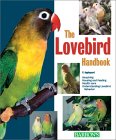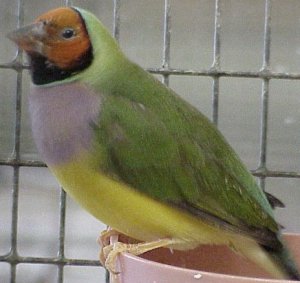Gouldian Finches: The Flying Mondrians
Few birds compare in beauty to the lovely Lady Gouldian Finches. I call them the “Flying Mondrians” because their exquisite, clearly demarcated colors remind me of the squares of color in a Mondrian painting. In the photo above the male is in the background, the female in front. You will notice that the colors are paler in the female of the species, making it easy to distinguish the sexes in this species of finch. There are a number of beautiful mutations of Gouldian finches as well.
The Gouldian Finch is often considered to be a very delicate bird. It is not one of the easiest finches to breed and many aviculturists keep Society Finches alongside them to serve as foster parents. Breeders who specialize in this species tend to have the most success since aviaries with mixed collections in large flights can run into problems with aggressive species and with overly meddlesome species (such as Zebra and Society finches). The biggest problem tends to be the abandonment of eggs or neonates. Many breeders recommend acclimating Gouldians to an outside aviary as this tends to create the hardiest lines.
One of the most deadly issues when keeping Gouldian Finches is prevention of air sac mites. The primary treatment for this is Ivermectin, which is also used to treat scaley mites in budgerigars. Some will also put a light dusting of Sevin powder in cages and nestboxes to prevent mites from reoccurring. It is strongly advised that you visit an avian veterinarian and not simply self-medicate your birds. The right dosage is essential.
Diet consists of a high-quality finch seed mix supplemented with canary seed, spray millet, cuttlebone, and assorted greens. Some supplement during breeding season with egg food or Pentamine. A small amount of grit should also be given in a separate dish.
These exceptional birds are not generally available at your local pet store. They tend to be found at stores that specialize in birds and at bird shows or marts. A good place to start if you are interested in this species is to contact a private breeder. They are much more expensive than the more commonly kept finches, ranging in price from $50 to hundreds of dollars for some rarer mutations. Some of the very new mutations will be out of most people’s price range. Read as much as you can on this species before diving in so you can be sure they are the right birds for your home.










